The Cabin Air Heater Market is estimated to be valued at USD 1.6 billion in 2025 and is projected to reach USD 3.4 billion by 2035, registering a compound annual growth rate (CAGR) of 7.8% over the forecast period.
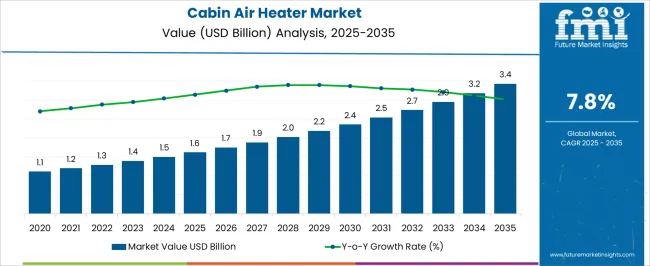
| Metric | Value |
|---|---|
| Cabin Air Heater Market Estimated Value in (2025 E) | USD 1.6 billion |
| Cabin Air Heater Market Forecast Value in (2035 F) | USD 3.4 billion |
| Forecast CAGR (2025 to 2035) | 7.8% |
The Cabin Air Heater market is experiencing strong growth driven by rising demand for thermal comfort and energy-efficient cabin heating solutions across commercial and passenger vehicles. In 2025, the market is characterized by increased adoption of diesel-powered and electric vehicle platforms, supported by manufacturers focusing on passenger comfort, driver safety, and emissions compliance. Technological advancements in compact and high-efficiency heater systems are enabling enhanced heat distribution with minimal energy consumption.
The market is also benefiting from rising commercial vehicle sales in emerging economies and stricter regulations for driver and passenger comfort in developed regions. The shift toward software-controlled cabin heating and integration with vehicle climate control systems is creating new opportunities for smart and modular heater solutions.
Ongoing developments in lightweight materials, fuel-efficient designs, and rapid warm-up technologies are anticipated to further improve performance and reduce operational costs As transportation operators increasingly prioritize driver comfort and operational efficiency, the Cabin Air Heater market is expected to sustain significant growth across multiple regions and vehicle types.
The cabin air heater market is segmented by vehicle type, fuel type, application, sales channel, and geographic regions. By vehicle type, cabin air heater market is divided into Commercial Vehicle (CV), Multi-Purpose Vehicle (MPV), Light Commercial Vehicle (LCV), and Heavy Commercial Vehicle (HCV). In terms of fuel type, cabin air heater market is classified into Diesel powered cabin air heater and Gasoline (Petrol) powered cabin air heater. Based on application, cabin air heater market is segmented into Automotive and Others (Marine & Aircraft). By sales channel, cabin air heater market is segmented into OEM and Aftermarket. Regionally, the cabin air heater industry is classified into North America, Latin America, Western Europe, Eastern Europe, Balkan & Baltic Countries, Russia & Belarus, Central Asia, East Asia, South Asia & Pacific, and the Middle East & Africa.
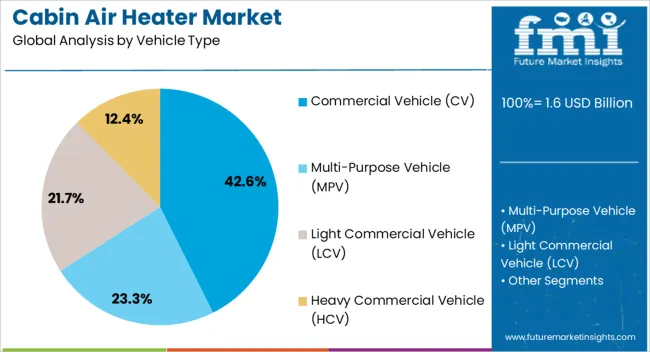
The Commercial Vehicle segment is projected to account for 42.60% of the Cabin Air Heater market revenue in 2025, establishing it as the leading vehicle type. This leadership is being driven by the extensive deployment of long-haul trucks, buses, and commercial transport vehicles that require effective heating solutions to ensure driver comfort and operational safety in cold climates. The adoption of cabin air heaters in commercial vehicles has been accelerated by rising fleet investments and regulatory focus on occupational health standards.
These systems are increasingly being integrated with advanced vehicle climate controls to maintain consistent cabin temperatures during prolonged trips, thereby reducing driver fatigue and enhancing safety. Growth in the logistics, transportation, and public transport sectors has further reinforced demand, as thermal comfort is essential for both drivers and passengers.
The modularity of modern cabin air heaters allows installation in a wide range of vehicle platforms without major redesign, supporting scalability and cost efficiency As commercial fleets continue to expand globally, the segment is expected to maintain its dominant market position through the adoption of high-performance and fuel-efficient heating systems.
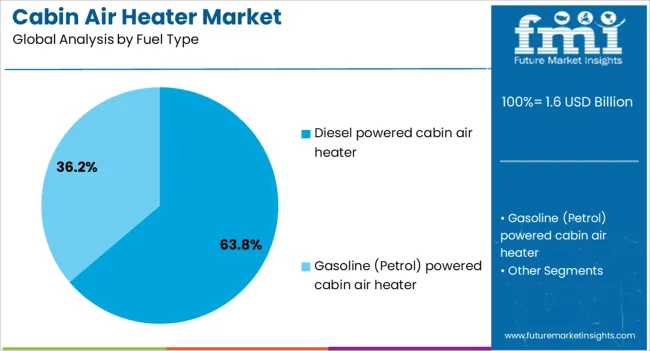
The Diesel Powered Cabin Air Heater segment is expected to hold 63.80% of the total market revenue in 2025, making it the leading fuel type. This dominance is being attributed to the widespread use of diesel engines in commercial vehicles, which provides compatibility with existing powertrain systems and ensures reliable heat output. Diesel-powered heaters are preferred for their high energy density, extended operational range, and ability to rapidly warm vehicle cabins in harsh climates.
The adoption of these systems is being further driven by operational efficiency, as diesel heaters consume less fuel compared to conventional auxiliary heating systems while providing consistent temperature control. Their robustness and long service life make them ideal for heavy-duty applications, including logistics, public transport, and construction vehicles.
Additionally, the integration of diesel cabin heaters with automated vehicle climate control systems allows fleet operators to monitor energy consumption and reduce idle fuel usage The segment’s growth is expected to continue as commercial fleets increasingly seek reliable and low-maintenance heating solutions capable of performing in extreme conditions while supporting overall operational efficiency.
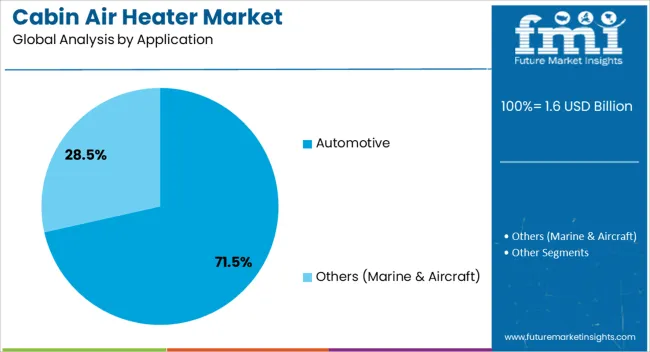
The Automotive application segment is projected to capture 71.50% of the Cabin Air Heater market revenue in 2025, making it the leading application. This growth is being supported by increasing vehicle production and the need for enhanced passenger comfort and safety. Cabin air heaters are being adopted extensively in vehicles to maintain optimal interior temperatures in cold climates, reduce fogging of windows, and ensure driver alertness during long drives.
The integration of these heaters with modern vehicle climate systems allows precise temperature control and energy optimization, contributing to reduced fuel consumption. Rising awareness among fleet operators and vehicle owners about the importance of cabin comfort has accelerated adoption, particularly in commercial transport and passenger vehicles.
Furthermore, technological advancements enabling rapid warm-up times, low energy consumption, and compact designs have enhanced applicability across a wide range of vehicle models As OEMs increasingly incorporate these systems into standard vehicle offerings, the automotive application segment is expected to retain its leadership position, driven by a combination of regulatory requirements, consumer expectations, and operational efficiency demands.
The main function of cabin air heater is to absorb heat generated by engine and suspension systems and supply in passenger compartment and cargo compartment in order to maintain desired temperature. Generally, cabin air heater is installed under the floors of the vehicle and in boats it is installed at the port locker. Everyday tons of merchandise are transported form one place to another place which requires fresh air at optimal temperature where a Cabin air heater serves the required purpose.
Cabin air heater is also installed in the boat at the port locker. Fresh air is being drawn from the cockpit with warm air outlets in the cabins, heads and saloon with the exhaust fitted above the waterline in the stern. On the basis of use, the cabin air heater can also be switched on or off for recirculating the air from the inside of the vehicle, or draw in fresh air. Cabin air heater is using mostly used in cold countries, hilly areas or mountain regions where generally temperature is in negative or very low.
Rising e-commerce in logistics coupled with growth of food services and catering are projected to drive the global cabin air heater market over the forecast period. Factors such as low fuel consumption, fast and easy installation, ease in check default components are likely to ramp up the demand and also expected to enrich the aftermarket segment of cabin air heater in the globe. Government regulation pertaining to installation and design of cabin air heater such as CARB and EPA is projected to drive the global cabin air heater market over the forecast period.
High initial cost owing to cabin air heater requires high quality temperature sensors such as altitude sensor and multi control sensors can augment the cabin air heater's price, which in turn, can hamper the cabin air heater market over the forecast period. Moreover, HVAC (Heating, ventilation and air conditioning is expected to be a prominent technology which is using currently, anticipated to hamper the global cabin air heater market in the coming years.
Leading cabin air heater manufacturers are focusing to enhance the heat output supply of cabin air heater. Furthermore, cabin air heater manufacturers such as Webasto are also developing wireless operated cabin air heater which can also operates through mobile apps.
Since, cabin air heater is operated by vehicle's fuel and does not require any extra accessories or equipment to operate it. Thereby, cabin air heater is representing high potential for electric vehicle in the forecast period. For instance, in September 2025, BorgWarner Inc. announced that it will supply cabin heating technology for new electric vehicles.
Europe is projected to dominate in the global cabin air heater market owing to high demand and rising disposal income over the forecast period. Italy, Spain, Austria, Sweden, Denmark and other are considered as cold country in Europe and anticipated to contribute significant share in the global cabin air heater market over the forecast period.
CIS countries (Kazakhstan) are expected to contribute considerable share in the cabin air heater market over the slated time period. North America is projected to be a prominent market for cabin air heater owing to rising logistics transportation in USA and Canada. Asia Pacific and Middle East & Africa regions are expected to account for minor share in the global cabin air heater market over the overcast period.
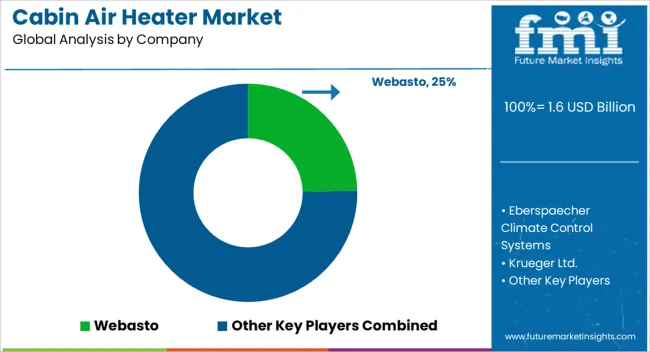
Global cabin air heater market is highly consolidated. Therefore, limited players are in the market. Although, some of the market participants in the Cabin Air Heater market identified across the value chain:
The research report on cabin air heater presents a comprehensive assessment of the market and contains thoughtful insights, facts, historical data, and statistically supported and industry-validated market data. The cabin air heater also contains projections using a suitable set of assumptions and methodologies. The cabin air heater research report provides analysis and information according to market segments such as geographies, application, and industry.
The report is a compilation of first-hand information, qualitative and quantitative assessment by industry analysts, inputs from industry experts and industry participants across the value chain. The report provides in-depth analysis of parent market trends, macro-economic indicators and governing factors along with market attractiveness as per segments. The report also maps the qualitative impact of various market factors on market segments and geographies.
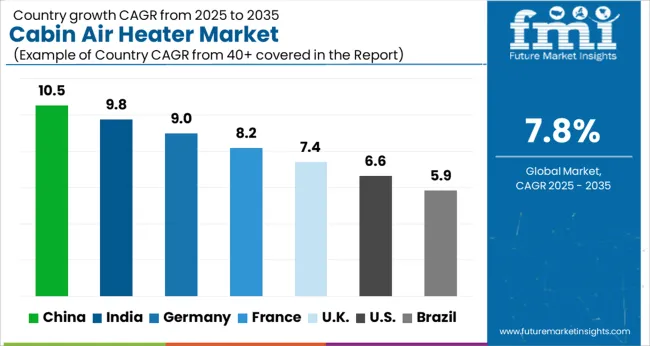
| Country | CAGR |
|---|---|
| China | 10.5% |
| India | 9.8% |
| Germany | 9.0% |
| France | 8.2% |
| UK | 7.4% |
| USA | 6.6% |
| Brazil | 5.9% |
The Cabin Air Heater Market is expected to register a CAGR of 7.8% during the forecast period, exhibiting varied country level momentum. China leads with the highest CAGR of 10.5%, followed by India at 9.8%. Developed markets such as Germany, France, and the UK continue to expand steadily, while the USA is likely to grow at consistent rates. Brazil posts the lowest CAGR at 5.9%, yet still underscores a broadly positive trajectory for the global Cabin Air Heater Market. In 2024, Germany held a dominant revenue in the Western Europe market and is expected to grow with a CAGR of 9.0%. The USA Cabin Air Heater Market is estimated to be valued at USD 572.9 million in 2025 and is anticipated to reach a valuation of USD 1.1 billion by 2035. Sales are projected to rise at a CAGR of 6.6% over the forecast period between 2025 and 2035. While Japan and South Korea markets are estimated to be valued at USD 77.5 million and USD 53.2 million respectively in 2025.
| Item | Value |
|---|---|
| Quantitative Units | USD 1.6 Billion |
| Vehicle Type | Commercial Vehicle (CV), Multi-Purpose Vehicle (MPV), Light Commercial Vehicle (LCV), and Heavy Commercial Vehicle (HCV) |
| Fuel Type | Diesel powered cabin air heater and Gasoline (Petrol) powered cabin air heater |
| Application | Automotive and Others (Marine & Aircraft) |
| Sales Channel | OEM and Aftermarket |
| Regions Covered | North America, Europe, Asia-Pacific, Latin America, Middle East & Africa |
| Country Covered | United States, Canada, Germany, France, United Kingdom, China, Japan, India, Brazil, South Africa |
| Key Companies Profiled | Webasto, Eberspaecher Climate Control Systems, Krueger Ltd., BorgWarner Inc., Eberspaecher group, Yachting Partners Malta LTD, Zhengzhou Yusenn Auto Technology Co., Ltd., and Planar Marine & Truck Air Heaters Ltd. |
The global cabin air heater market is estimated to be valued at USD 1.6 billion in 2025.
The market size for the cabin air heater market is projected to reach USD 3.4 billion by 2035.
The cabin air heater market is expected to grow at a 7.8% CAGR between 2025 and 2035.
The key product types in cabin air heater market are commercial vehicle (cv), multi-purpose vehicle (mpv), light commercial vehicle (lcv) and heavy commercial vehicle (hcv).
In terms of fuel type, diesel powered cabin air heater segment to command 63.8% share in the cabin air heater market in 2025.






Our Research Products

The "Full Research Suite" delivers actionable market intel, deep dives on markets or technologies, so clients act faster, cut risk, and unlock growth.

The Leaderboard benchmarks and ranks top vendors, classifying them as Established Leaders, Leading Challengers, or Disruptors & Challengers.

Locates where complements amplify value and substitutes erode it, forecasting net impact by horizon

We deliver granular, decision-grade intel: market sizing, 5-year forecasts, pricing, adoption, usage, revenue, and operational KPIs—plus competitor tracking, regulation, and value chains—across 60 countries broadly.

Spot the shifts before they hit your P&L. We track inflection points, adoption curves, pricing moves, and ecosystem plays to show where demand is heading, why it is changing, and what to do next across high-growth markets and disruptive tech

Real-time reads of user behavior. We track shifting priorities, perceptions of today’s and next-gen services, and provider experience, then pace how fast tech moves from trial to adoption, blending buyer, consumer, and channel inputs with social signals (#WhySwitch, #UX).

Partner with our analyst team to build a custom report designed around your business priorities. From analysing market trends to assessing competitors or crafting bespoke datasets, we tailor insights to your needs.
Supplier Intelligence
Discovery & Profiling
Capacity & Footprint
Performance & Risk
Compliance & Governance
Commercial Readiness
Who Supplies Whom
Scorecards & Shortlists
Playbooks & Docs
Category Intelligence
Definition & Scope
Demand & Use Cases
Cost Drivers
Market Structure
Supply Chain Map
Trade & Policy
Operating Norms
Deliverables
Buyer Intelligence
Account Basics
Spend & Scope
Procurement Model
Vendor Requirements
Terms & Policies
Entry Strategy
Pain Points & Triggers
Outputs
Pricing Analysis
Benchmarks
Trends
Should-Cost
Indexation
Landed Cost
Commercial Terms
Deliverables
Brand Analysis
Positioning & Value Prop
Share & Presence
Customer Evidence
Go-to-Market
Digital & Reputation
Compliance & Trust
KPIs & Gaps
Outputs
Full Research Suite comprises of:
Market outlook & trends analysis
Interviews & case studies
Strategic recommendations
Vendor profiles & capabilities analysis
5-year forecasts
8 regions and 60+ country-level data splits
Market segment data splits
12 months of continuous data updates
DELIVERED AS:
PDF EXCEL ONLINE
Air Preheater Market
Airport Cabin Baggage Scanner Market Size and Share Forecast Outlook 2025 to 2035
Aircraft Cabin Environment Sensor Market Forecast and Outlook 2025 to 2035
Aircraft Cabin Interior Market Size and Share Forecast Outlook 2025 to 2035
Aircraft Cabin Interior Market Analysis - Size, Share, and Forecast Outlook 2025 to 2035
Aircraft Cabin Interiors Market Size and Share Forecast Outlook 2025 to 2035
Laminar Airflow Cabinet Market Size and Share Forecast Outlook 2025 to 2035
Industrial Air Heater Market
High Airtight Storage Cabinets Market Size and Share Forecast Outlook 2025 to 2035
Automotive Cabin Air Quality Sensors Market Size and Share Forecast Outlook 2025 to 2035
Commercial Aircraft Cabin Interior Market Size and Share Forecast Outlook 2025 to 2035
Air Fryer Paper Liners Market Size and Share Forecast Outlook 2025 to 2035
Air Struts Market Size and Share Forecast Outlook 2025 to 2035
Airless Paint Spray System Market Size and Share Forecast Outlook 2025 to 2035
Air Caster Skids System Market Size and Share Forecast Outlook 2025 to 2035
Airborne Molecular Contamination Control Services Market Forecast and Outlook 2025 to 2035
Airflow Balancer Market Size and Share Forecast Outlook 2025 to 2035
Aircraft Flight Control System Market Size and Share Forecast Outlook 2025 to 2035
Airborne Radar Market Size and Share Forecast Outlook 2025 to 2035
Aircraft Electric Motor Market Forecast Outlook 2025 to 2035

Thank you!
You will receive an email from our Business Development Manager. Please be sure to check your SPAM/JUNK folder too.
Chat With
MaRIA